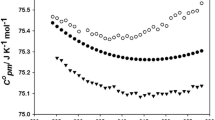Abstract
Thermochemical properties of the 1-ethyl-3-methylimidazolium bis(trifluoromethylsulfonyl) imide ionic liquid [EMim]NTf2 containing moisture absorbed from the atmosphere (0.242 wt %) are investigated. The phase behavior and thermal stability relative to salt dried in vacuum are studied by means of thermogravimetry and differential scanning calorimetry at different heating and cooling rates. The glass transition, crystallization, and melting temperatures, the enthalpies of phase transitions, and the changes in heat capacity during the formation of glass are determined. It is established that the absorbed water crystallizes at a temperature of around −40.6°C and has virtually no effect on the thermal stability and phase behavior of the salt. Rapid cooling results in the ionic liquid transitioning into the glass state at −91.7 °C and the formation of three mesophases with different melting temperatures; one crystalline modification that melts at a temperature of −19.3°C forms upon slow cooling.
Similar content being viewed by others
References
P. Wassersheid and T. Welton, Ionic Liquids in Synthesis (Wiley-VCH, Weinheim, 2003).
J. P. Hallett and T. Welton, Chem. Rev. 111, 3508 (2011).
J. F. Wishart, Energy Environ. Sci. 2, 956 (2009).
H. L. Ngo, K. LeCompte, L. Hargens, et al., Thermochim. Acta 357–358, 97 (2000).
K. R. Seddon, A. Stark, and M.-J. Torres, Pure Appl. Chem. 72, 2275 (2000).
L. M. Ramenskaya, E. P. Grishina, A. M. Pimenova, and M. S. Gruzdev, Russ. J. Phys. Chem. A 82, 1098 (2008).
M. S. Gruzdev, L. M. Ramenskaya, U. V. Chervonova, and R. S. Kumeev, Russ. J. Gen. Chem. 79, 1720 (2009).
L. M. Ramenskaya, E. P. Grishina, and S. S. Guseinov, Zh. Fiz. Khim. 88, 1020 (2014).
P. Bonhôte, A.-P. Dias, N. Papageorgiou, et al., Inorg. Chem. 35, 1168 (1996).
A. B. McEwen, H. L. Ngo, K. LeCompte, et al., Appl. J. Electrochem. Soc. 146, 1687 (1999).
H. Matsumoto, M. Yanagida, K. Tanimoto, et al., Chem. Lett. 29, 922 (2000).
D. R. MacFarlane, P. Meakin, N. Amini, and M. Forsyth, J. Phys.: Condens. Matter 13, 8257 (2001).
A. Noda, K. Hayamizu, and M. Watanabe, J. Phys. Chem. B 105, 4603 (2001).
S. V. Dzyuba and R. A. Bartsch, Chem. Phys. Chem. 3, 161 (2002).
C. P. Fredlake, J. M. Crosthwaite, D. G. Hert, et al., J. Chem. Eng. Data 49, 954 (2004).
H. Tokuda, K. Hayamizu, K. Ishii, et al., J. Phys. Chem. B 109, 6103 (2005).
Md. A. B. H. Susan, T. Kaneko, N. Akihiro, and M. Watanabe, J. Am. Chem. Soc. 127, 4976 (2005).
M. Ishikawa, T. Sugimoto, M. Kikuta, et al., J. Power Sourses 162, 658 (2006).
Y. U. Paulechka, A. V. Blokhin, G. J. Kabo, and A. A. Strechan, J. Chem. Thermodyn. 39, 866 (2007).
E. P. Grishina, L. M. Ramenskaya, M. S. Gruzdev, and O. V. Kraeva, J. Mol. Liq. 177, 267 (2013).
S. V. Dzyuba and R. A. Bartsch, Tetrahedron Lett. 43, 4657 (2002).
M. Galiński, A. Lewandowski, and I. Stepniak, Electrochim. Acta 51, 5567 (2006).
W. A. Henderson and S. Passerini, Chem. Mater. 16, 2881 (2004).
Z. H. Zhang, T. Cui, J. L. Zhang, et al., J. Therm. Anal. Calorim. 101, 1143 (2010).
A. V. Blokhin, Y. U. Paulechka, A. A. Strechan, and G. J. Kabo, J. Phys. Chem. B 112, 4357 (2008).
J. J. Moura Ramos, C. A. M. Afonso, and L. C. Branco, J. Therm. Anal. Calorim. 71, 659 (2003).
Author information
Authors and Affiliations
Corresponding author
Additional information
Original Russian Text © L.M. Ramenskaya, E.P. Grishina, N.O. Kudryakova, 2018, published in Zhurnal Fizicheskoi Khimii, 2018, Vol. 92, No. 1, pp. 30–35.
Rights and permissions
About this article
Cite this article
Ramenskaya, L.M., Grishina, E.P. & Kudryakova, N.O. Thermochemical Properties of the 1-Ethyl-3-Methylimidazolium Bis(trifluoromethylsulfonyl)imide Ionic Liquid under Conditions of Equilibrium with Atmospheric Moisture. Russ. J. Phys. Chem. 92, 24–28 (2018). https://doi.org/10.1134/S003602441801020X
Received:
Published:
Issue Date:
DOI: https://doi.org/10.1134/S003602441801020X




